| a | b | c | d | e | f | g | h | ||
| 8 |  | 8 | |||||||
| 7 | 7 | ||||||||
| 6 | 6 | ||||||||
| 5 | 5 | ||||||||
| 4 | 4 | ||||||||
| 3 | 3 | ||||||||
| 2 | 2 | ||||||||
| 1 | 1 | ||||||||
| a | b | c | d | e | f | g | h | ||
The ferz or fers is a fairy chess piece that may move one square diagonally. [1] It was used in orthodox chess and in Shatranj form of chess before being replaced by the queen.
| a | b | c | d | e | f | g | h | ||
| 8 |  | 8 | |||||||
| 7 | 7 | ||||||||
| 6 | 6 | ||||||||
| 5 | 5 | ||||||||
| 4 | 4 | ||||||||
| 3 | 3 | ||||||||
| 2 | 2 | ||||||||
| 1 | 1 | ||||||||
| a | b | c | d | e | f | g | h | ||
The ferz or fers is a fairy chess piece that may move one square diagonally. [1] It was used in orthodox chess and in Shatranj form of chess before being replaced by the queen.

The ferz is a very old piece, appearing in chaturanga and shatranj, the ancestors of all chess variants; it also featured in games such as Tamerlane chess. The ferz was a standard chess piece until the modern moves of queen and bishop were developed around the 15th century, with the ferz being replaced by the former.
The ferz also appears in some large historical shogi variants, such as in dai shogi under the name cat sword (猫刄 myōjin). The Thai variant of chess, makruk, retains the ferz from shatranj as the "Met", both as a starting piece and as the only pawn promotion option. Thus, much of shatranj endgame theory is also valid for makruk.
The piece was originally called the mantri (Sanskrit for "minister" or "counsellor"), which was translated by the Persians to farzin or farzīn (فرزین), which means "counsellor" or "wise man". This was shortened to ferz, and this became firz or fers in Medieval Europe. Its name later changed to queen , but when that name started being used for the modern chess queen, its former name ferz or fers began to be used in chess problems. In modern Eastern Slavic languages, however, ferz (ферзь) is the current name for the chess queen.
The ferz by itself is worth about half a knight. A king and three ferzes can force checkmate on a bare king if not all three ferzes are on the same square color; a king and two ferzes on opposite-colored squares can force stalemate on a bare king, [2] but not easily, and they cannot force checkmate. The endgame of rook versus ferz is a win for the rook. Despite being colorbound, the ferz is the strongest of the basic leapers during the opening phase of the game, even stronger than the wazir, due to its larger mobility forward. A wazir and a ferz can force checkmate on a bare king only if the bare king is significantly close to a corner that is the same color square as that of the ferz. While a knight and wazir can usually force checkmate against a bare king, a knight and ferz can only do so if the bare king is significantly close to a corner that is the same color square as that of the ferz. The wazir is better than the ferz in most endgames because of the wazir's ability to restrict squares adjacent to the squares last restricted.
Both white and black symbols for the ferz have been provisionally accepted for a future version of the Unicode standard, in the Chess Symbols block: [3] [4]
U+1FA54 WHITE CHESS FERZ
U+1FA56 BLACK CHESS FERZ
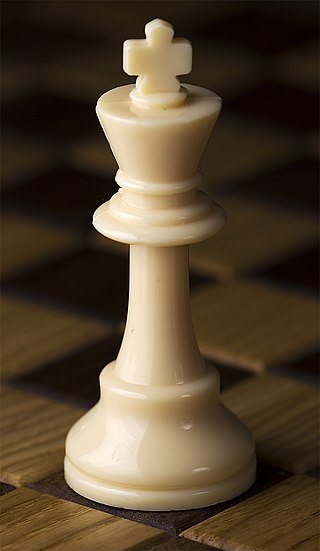
The king is the most important piece in the game of chess. It may move to any adjoining square; it may also perform, in tandem with the rook, a special move called castling. If a player's king is threatened with capture, it is said to be in check, and the player must remove the threat of capture immediately. If this cannot be done, the king is said to be in checkmate, resulting in a loss for that player. A player cannot make any move that places their own king in check. Despite this, the king can become a strong offensive piece in the endgame or, rarely, the middlegame.

The queen is the most powerful piece in the game of chess. It can move any number of squares vertically, horizontally or diagonally, combining the powers of the rook and bishop. Each player starts the game with one queen, placed in the middle of the first rank next to the king. Because the queen is the strongest piece, a pawn is promoted to a queen in the vast majority of cases.
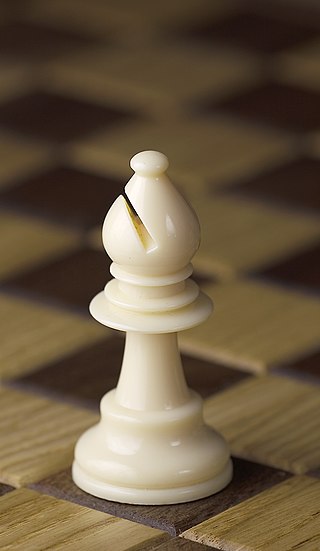
The bishop is a piece in the game of chess. It moves and captures along diagonals without jumping over intervening pieces. Each player begins the game with two bishops. The starting squares are c1 and f1 for White's bishops, and c8 and f8 for Black's bishops.

A chess piece, or chessman, is a game piece that is placed on a chessboard to play the game of chess. It can be either white or black, and it can be one of six types: king, queen, rook, bishop, knight, or pawn.
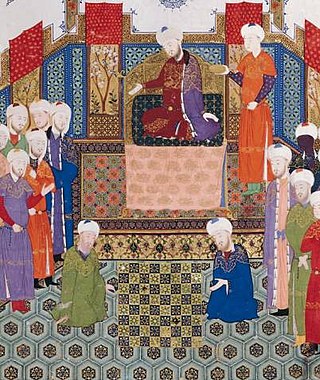
Shatranj is an old form of chess, as played in the Sasanian Empire. Its origins are in the Indian game of chaturaṅga. Modern chess gradually developed from this game, as it was introduced to Europe by contacts in Muslim Al-Andalus and in Sicily in the 10th century.

Chaturanga is an ancient Indian strategy board game. It is first known from India around the seventh century CE, but its roots may date 5000 years back[from the seventh century CE, or from today ?], to the Indus Valley Civilization.
A fairy chess piece, variant chess piece, unorthodox chess piece, or heterodox chess piece is a chess piece not used in conventional chess but incorporated into certain chess variants and some chess problems. Compared to conventional pieces, fairy pieces vary mostly in the way they move, but they may also follow special rules for capturing, promotions, etc. Because of the distributed and uncoordinated nature of unorthodox chess development, the same piece can have different names, and different pieces can have the same name in various contexts as it can be noted in the list of fairy chess pieces.
Stalemate is a situation in chess where the player whose turn it is to move is not in check and has no legal move. Stalemate results in a draw. During the endgame, stalemate is a resource that can enable the player with the inferior position to draw the game rather than lose. In more complex positions, stalemate is much rarer, usually taking the form of a swindle that succeeds only if the superior side is inattentive. Stalemate is also a common theme in endgame studies and other chess problems.
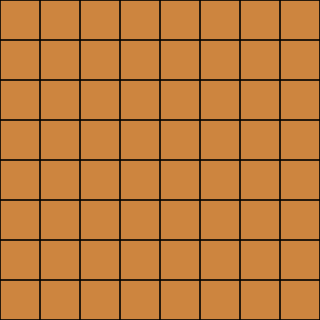
Makruk, or Thai chess, is a strategy board game that is descended from the 6th-century Indian game of chaturanga or a close relative thereof, and is therefore related to chess. It is part of the family of chess variants.
Tamerlane chess is a medieval chess variant. Like modern chess, it is derived from shatranj. It was developed in Central Asia during the reign of Emperor Timur, and its invention is also attributed to him. Because Tamerlane chess is a larger variant of chaturanga, it is also called Shatranj Al-Kabir, as opposed to Shatranj as-saghir. Although the game is similar to modern chess, it is distinctive in that there are varieties of pawn, each of which promotes in its own way.

The empress is a fairy chess piece that can move like a rook or a knight. It cannot jump over other pieces when moving as a rook but may do so when moving as a knight. The piece has acquired many names and is frequently called a chancellor or a marshal.

The princess is a fairy chess piece that can move like a bishop or a knight. It cannot jump over other pieces when moving as a bishop but may do so when moving as a knight. The piece has acquired many names and is frequently called an archbishop or a cardinal; it may also simply be called the bishop+knight compound.
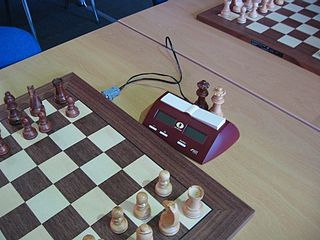
In chess, promotion is the replacement of a pawn with a new piece when the pawn is moved to its last rank. The player replaces the pawn immediately with a queen, rook, bishop, or knight of the same color. The new piece does not have to be a previously captured piece. Promotion is mandatory when moving to the last rank; the pawn cannot remain as a pawn.

The following outline is provided as an overview of and topical guide to chess:

The amazon, also known as the queen+knight compound or the dragon, is a fairy chess piece that can move like a queen or a knight. It may thus be considered the sum of all orthodox chess pieces other than the king and the pawn. The amazon can force checkmate on an enemy king without the help of any other friendly piece.
The wazir or vazir is a fairy chess piece that may move a single square vertically or horizontally. In notation, it is given the symbol W. In this article, the wazir is represented by an inverted rook.

The pil, alfil, alpil, or elephant is a fairy chess piece that can jump two squares diagonally. It first appeared in shatranj. It is used in many historical and regional chess variants. It was used in standard chess before being replaced by the bishop in the 15th and 16th centuries.
The camel or long knight is a fairy chess piece with an elongated knight move. It can jump three squares horizontally and one square vertically or three squares vertically and one square horizontally, regardless of intervening pieces. Therefore, it is a (1,3)-leaper.

The mann or man is a fairy chess piece that may move to any adjoining square. It is similar to the king, but it is not a royal piece, and it cannot castle. The mann is used in many chess variants. In this article's diagrams, the mann is represented by an inverted king.
Bibliography